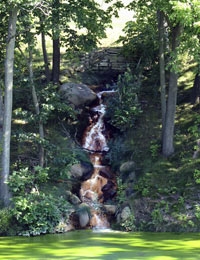Inside Iowa State
Inside ArchivesSubmit newsSend news for Inside to inside@iastate.edu, or call (515) 294-7065. See publication dates, deadlines. About InsideInside Iowa State, a newspaper for faculty and staff, is published by the Office of University Relations. |
Aug. 10, 2006 It's not easy being greenby Erin Rosacker As much of the Midwest sizzles through one of driest summers in recent memory, a trip to Veenker Memorial Golf Course reveals lush, green grass that beckons to bare feet. With rivers down to a trickle and the looming threat of water restrictions, how can such pristine turf be possible? 
The pump station at the holding pond distributes water to the irrigation system. 
When needed, the well water pumped out from the power plant cascades down a waterfall into the holding pond. The waterfall can also be fed by recirculated pond water for aesthetics. Believe it or not, the irrigation system at the course minimizes its water demands with a combination of technology and common-sense resource management. It's probably a safe bet that dry weather causes many homeowners to overcompensate and water their lawns too much, but computerized irrigation systems help golf courses maximize every drop. "I think golf courses in general try to conserve water as much as possible," said John Newton, who is in his 22nd season as Veenker's course manager and superintendent. "I think our understanding of the resources that we have and the damage that can be caused from over-watering is greater than the damage of less watering, as far as we're concerned." A tweak here and thereNewton can tell you exactly how much moisture was lost to the elements each day by using readouts from the weather station near the first tee box. The readings calculate water loss -- or evapotransporation (ET) rate -- and Newton adjusts the daily watering schedule to replenish that accordingly. That doesn't mean turning on the sprinklers for a couple hours. It means logging on to a computer for precision control of approximately 750 sprinkler heads scattered over 200 acres. After getting the ET rate around 8 p.m., the sprinklers are generally set to replace 65 percent of the day's water loss. Each sprinkler can be adjusted individually, giving Newton the ability to control specific areas. For instance, the amount of water Newton uses on the fairways is about three-fourths of the 65 percent standard for greens and tee boxes. "My goal is to not have wet turf, my goal is to have turf that is green," Newton said. "No extra water. So if I can tweak these numbers down, I will." He takes a daily tour of the course around 5:45 a.m., checking for any problems. If an area looks too wet or too dry, adjustments can be made for the next round of irrigation that night. If he finds any hot spots showing "wilt," that area may get some additional TLC in the form of a few minutes of hand-watering with a hose during the hottest part of the day. "As we can tweak it, we create a more consistent playing surface for the players and we can use less water," Newton said. "My irrigation system, I call it my tool to save water rather than my tool to spend water." Utilizing runoff waterVeenker doesn't use any water from the City of Ames. The primary source of water comes from the holding pond located near the fifth hole in the southwest corner of the course, which is fed by a stream that collects runoff water from the neighboring areas. Newton says the pond holds about four to five days of irrigation. If the pond isn't replenished by Mother Nature, then they turn on the pumps to transport well water from the ISU power plant. "We probably get about 50 percent of our water from runoff water," Newton estimated. In all, Newton estimates Veenker's total irrigation water usage at approximately 22 million gallons per year. Future plans could replace the use of well water by recycling the water coming off the power plant's cooling towers. |
SummaryKeeping Veenker Memorial Golf Course green during the summer is a science, using technology to conserve water by maximizing every drop. Quote"My goal is to not have wet turf, my goal is to have turf that is green. No extra water." John Newton, Veenker Memorial Golf Course manager and superintendent |